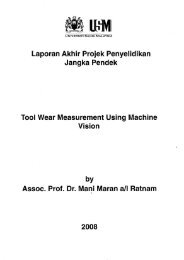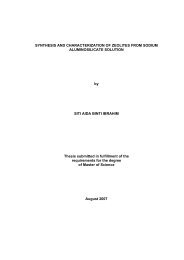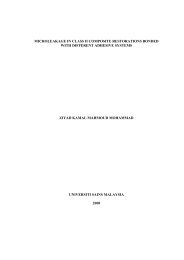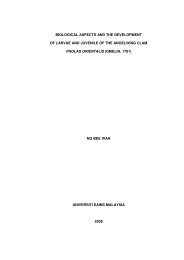a study on the performance of limestone roughing filter - ePrints@USM
a study on the performance of limestone roughing filter - ePrints@USM
a study on the performance of limestone roughing filter - ePrints@USM
You also want an ePaper? Increase the reach of your titles
YUMPU automatically turns print PDFs into web optimized ePapers that Google loves.
smaller interstices between smaller media, as well as <strong>the</strong> larger surface area available,<br />
which allow more adsorpti<strong>on</strong>. A smaller size <strong>of</strong> <strong>filter</strong> media will have a larger total<br />
surface area available for bi<strong>of</strong>ilms to grow <strong>on</strong>, and <strong>the</strong>refore more bi<strong>of</strong>ilm can be<br />
exposed to raw water. Therefore, removal efficiency increases.<br />
The empty space or pore size within a <strong>filter</strong> medium is important for<br />
determining <strong>the</strong> right <strong>filter</strong> size and efficiency. Pore size is a measure <strong>of</strong> how much <strong>of</strong><br />
<strong>the</strong> medium c<strong>on</strong>sists <strong>of</strong> empty space. The <strong>filter</strong> efficiency depends <strong>on</strong> <strong>the</strong> ratio <strong>of</strong> <strong>filter</strong><br />
media surface area to its volume, which means total specific surface area (SSA) per<br />
cubic metre. Despite this enormous SSA, sand would make a poor <strong>filter</strong> medium<br />
because <strong>the</strong> small particle size would so<strong>on</strong> lead to blockages. Because <strong>of</strong> <strong>the</strong> dense<br />
packing, any flow through <strong>the</strong> sand would be very slow. Therefore despite its massive<br />
surface area, <strong>the</strong> volume <strong>of</strong> water that could be treated per hour would actually be quite<br />
small (FishDoc, 2004). For a medium such as gravel, it is larger in size and less in SSA<br />
that would make it less pr<strong>on</strong>e to blocking. Special media such as <strong>filter</strong> matting, plastic<br />
or sintered glass, have both a large SSA and a generous void space. In fact, many <strong>of</strong><br />
<strong>the</strong>m are more than 90% void or empty space. This makes blockage almost impossible<br />
(FishDoc, 2004).<br />
Filtrati<strong>on</strong> rate also has a significant influence <strong>on</strong> <strong>the</strong> particle removal. Many<br />
reports described that good removals in <strong>the</strong> <strong>roughing</strong> <strong>filter</strong>s were achieved at low<br />
filtrati<strong>on</strong> rates. It is attributable that low filtrati<strong>on</strong> rates give support to retain particles<br />
that are gravitati<strong>on</strong>ally deposited to <strong>the</strong> upper side <strong>of</strong> <strong>filter</strong> media. It is important to have<br />
laminar flow c<strong>on</strong>diti<strong>on</strong>s. In Figure 2.6, Wegelin (1996) revealed that filtrati<strong>on</strong> rate<br />
greatly influence <strong>the</strong> <strong>filter</strong> efficiency. Flow c<strong>on</strong>diti<strong>on</strong>s are described by Reynolds<br />
number. At Reynolds number less than 10, laminar flow can be expected. Removal<br />
efficiency increases with decreasing Reynolds Number (Re). According to Figure 2.6,<br />
turbidity removal was 40% at a Re <strong>of</strong> 8, whereas removal was greater than 80% at Re<br />
20

















